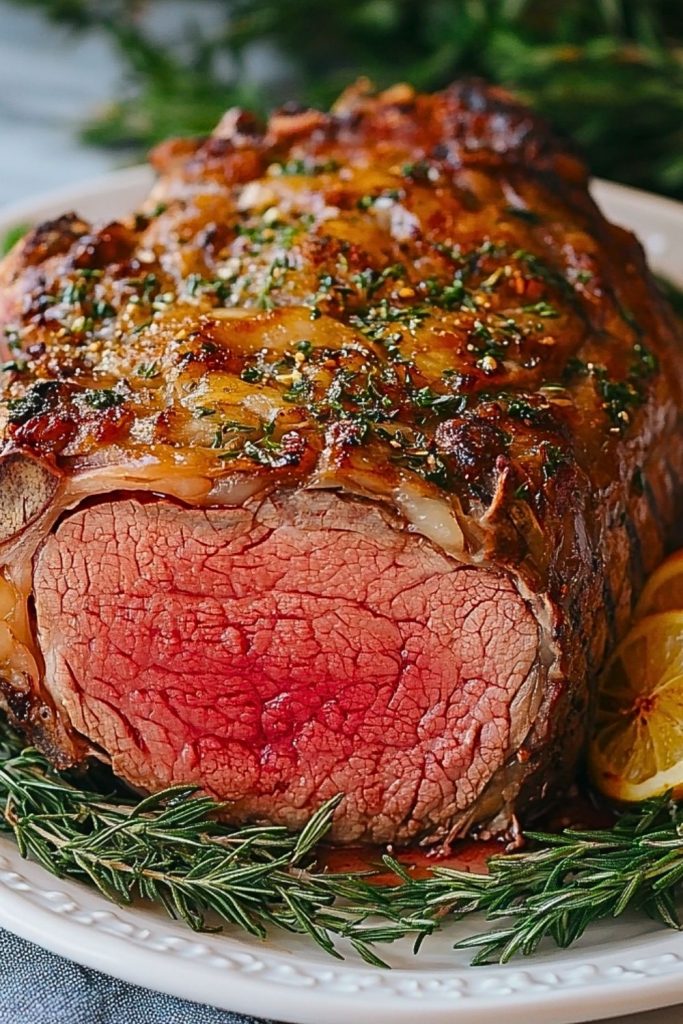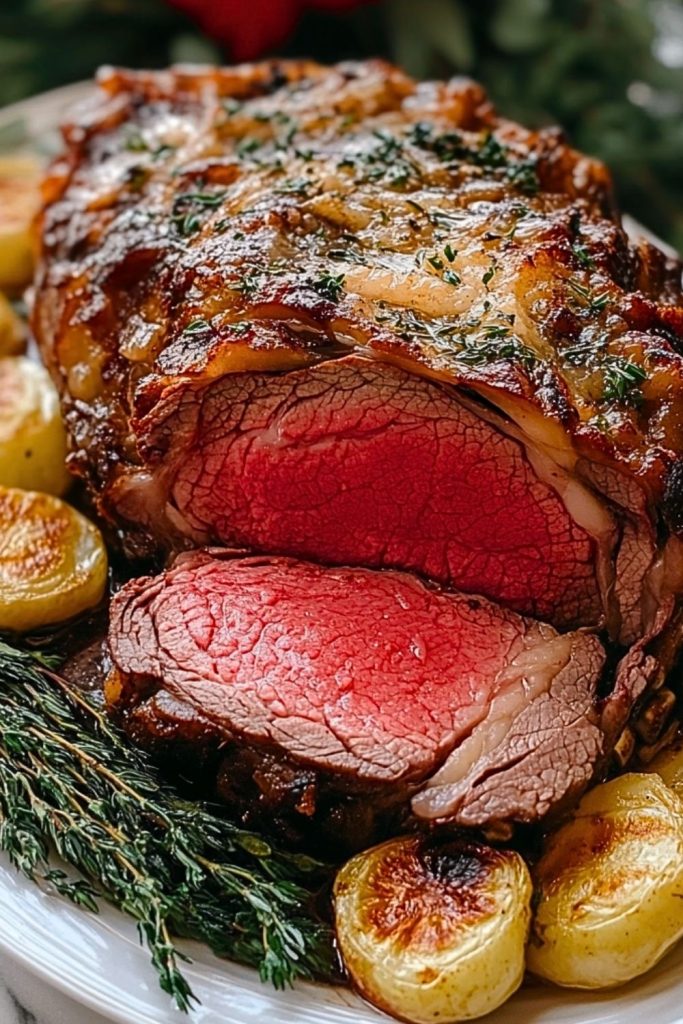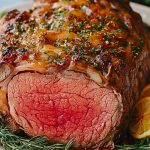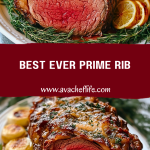There’s something special about the moment you slice into a perfectly roasted prime rib—the aroma of garlic and rosemary, the crispy, golden crust, and that rich, pink center that melts in your mouth. This Best Ever Prime Rib is my go-to showstopper when I want to impress guests or treat myself to a comforting, indulgent meal. Whether it’s a holiday gathering or a quiet weekend dinner, this roast turns any meal into a celebration.

I’ve made a lot of roasts over the years, but this one wins every time. The flavors are bold yet balanced: herbaceous crust, tender beef, and just the right hint of citrus from lemon garnishes. It’s a surprisingly easy dish once you understand the steps—and once you taste it, you’ll see why it’s worth every minute of the process.
Why You’ll Love This Prime Rib
This prime rib isn’t just another roast—it’s an experience. You’ll love how the outside forms a savory crust that’s packed with flavor from garlic, fresh herbs, and a touch of mustard. The inside stays incredibly juicy and tender thanks to a low-and-slow roasting method that never fails. Plus, it’s naturally low-carb and keto-friendly, making it perfect for various dietary needs. Whether you’re feeding a crowd or just treating yourself, this dish checks every box: stunning, satisfying, and surprisingly simple.
What Cut of Beef Should I Use for Prime Rib?
When it comes to prime rib, the cut you choose matters more than you might think. Ideally, you want a standing rib roast—which comes from the primal rib section of the cow. This is the same region that ribeye steaks are cut from, so you’re guaranteed rich marbling and bold flavor. You can choose between bone-in or boneless, but I always go for bone-in. The bones help insulate the meat during cooking, giving it even more flavor and tenderness.
If you’re buying from a butcher, ask for a prime grade rib roast. It’s more marbled and juicy than choice grade, although choice still makes for a fantastic roast. For small gatherings, a 3-bone roast is perfect. Feeding a crowd? Go big with 5 to 7 ribs—it’s a centerpiece worth showing off.
Options for Substitutions
Prime rib is the star, but you’ve got a little flexibility when it comes to ingredients and cooking techniques:
- Boneless Ribeye Roast: Still incredibly tender, and easier to carve—just monitor the temperature closely.
- New York Strip Roast: A leaner alternative with a firmer bite. Not as juicy as rib roast, but still delicious when roasted right.
- Herb Variations: If rosemary isn’t your thing, swap it with thyme, oregano, or sage.
- Garlic Alternatives: Try shallots or even a shallot-garlic blend for a different flavor twist.
- Dijon Mustard Substitute: Don’t have it? Use horseradish or a grainy mustard for similar tang and richness.
Whether you’re adjusting for availability or personal taste, these substitutions keep the roast flavorful and still worthy of its “Best Ever” title.
Ingredients for This Best Ever Prime Rib
To make this roast unforgettable, each ingredient plays a specific role in enhancing flavor, texture, and aroma. Here’s what you’ll need and why it matters:
- Prime Rib Roast (Bone-In): The star of the show—richly marbled, flavorful, and tender when cooked properly. Bone-in adds extra moisture and depth.
- Kosher Salt: Essential for drawing out moisture from the surface to help develop that crispy, savory crust.
- Freshly Cracked Black Pepper: Adds a bold kick and balances the richness of the meat.
- Garlic Cloves: Minced and rubbed into the meat for aromatic intensity and earthy depth.
- Fresh Rosemary: Brings woodsy, herbal brightness that pairs beautifully with beef.
- Fresh Thyme: Delicate and slightly minty, thyme enhances the roast without overpowering it.
- Dijon Mustard: A secret weapon—it helps the herb crust adhere while adding tangy complexity.
- Olive Oil or Butter: Moisturizes the crust and carries the flavors of the herbs and garlic.
- Lemon Slices (Optional Garnish): Adds a fresh pop of brightness and a lovely visual touch when serving.
Every ingredient here is chosen with care to elevate the roast from good to absolutely unforgettable.

Step 1: Prepare the Prime Rib
Start by removing the roast from the fridge at least 1 to 2 hours before cooking. Letting it come to room temperature ensures even cooking throughout. Pat it dry with paper towels to help the crust form better in the oven.
Step 2: Make the Herb Crust
In a small bowl, mix together minced garlic, chopped rosemary, chopped thyme, Dijon mustard, olive oil (or melted butter), kosher salt, and black pepper. This mixture should be thick and fragrant. Rub it generously all over the roast—get into every nook and cranny.
Step 3: Tie It Up (Optional but Recommended)
If your butcher hasn’t already, use kitchen twine to tie the roast every 1.5–2 inches. This helps the meat hold its shape during roasting and makes for more even cooking.
Step 4: Sear for Extra Flavor (Optional)
For a deeper crust, you can sear the roast in a hot skillet for 2–3 minutes on each side before roasting. This step is optional but adds a caramelized layer of flavor.
Step 5: Roast Low and Slow
Preheat your oven to 250°F (120°C). Place the roast bone-side down on a rack in a roasting pan. Insert a meat thermometer into the thickest part. Roast slowly until the internal temp hits:
- 120°F for rare
- 130°F for medium-rare
- 140°F for medium
Expect this to take 3–5 hours, depending on size.
Step 6: Rest and Crust
Once the roast reaches your target internal temp, remove it from the oven and let it rest for 30–45 minutes, tented loosely with foil. This locks in the juices. Then, increase oven temp to 500°F (260°C) and return the roast for 8–10 minutes to create that golden, crunchy crust.
Step 7: Slice and Serve
Use a sharp carving knife to cut between the bones for thick, juicy slices. Serve with pan drippings or horseradish sauce for extra decadence.
How Long to Cook the Prime Rib
The cooking time for prime rib depends on the size of the roast and your preferred level of doneness. Here’s a general guideline based on a low-and-slow oven method at 250°F (120°C):
- Rare (120°F internal temp): ~25 minutes per pound
- Medium-Rare (130°F internal temp): ~28–30 minutes per pound
- Medium (140°F internal temp): ~30–35 minutes per pound
So, a 6-pound roast at medium-rare will take approximately 3 hours, plus resting and final browning time. Always rely on a meat thermometer for accuracy—time estimates can vary by oven and roast thickness.
Don’t forget: after the rest, the roast goes back into a 500°F oven for 8–10 minutes to get that mouthwatering crust.
Tips for Perfect Prime Rib
- Use a Meat Thermometer: This is non-negotiable. It’s the only way to guarantee a perfect doneness.
- Let the Roast Rest: After roasting, rest the meat for at least 30 minutes before slicing. This keeps juices locked in.
- Dry the Meat First: Patting the roast dry before seasoning ensures the crust crisps up beautifully.
- Herb Crust Layering: Don’t skimp on the mustard-herb rub. It creates the bold outer flavor that defines this roast.
- Rack It Up: Use a roasting rack to elevate the roast. Air circulation promotes even cooking and keeps the bottom from steaming.
- Crank the Heat at the End: That final blast in the oven at high temp makes all the difference for texture and appearance.
- Start at Room Temp: Cold meat cooks unevenly. Let the roast sit out before you begin.
- Save the Bones: They’re full of flavor and make fantastic stock or beefy soup bases later.
These tips take the guesswork out and help you consistently hit “wow” with every bite.
Watch Out for These Mistakes While Cooking
Even a gorgeous cut of meat like prime rib can go sideways if you’re not careful. Here are the common pitfalls to avoid:
- Skipping the Thermometer: Don’t rely on guesswork or cook times alone—prime rib is too premium to risk over- or undercooking.
- Cooking Straight from the Fridge: If the roast is cold in the center, it’ll cook unevenly and dry out around the edges.
- Not Letting It Rest: Cutting into the meat too soon lets all the juices escape, leaving it dry and disappointing.
- Overseasoning: Prime rib is rich and flavorful already. Go big on herbs and aromatics, but be measured with the salt.
- Underestimating Carryover Cooking: The roast continues to cook after it comes out of the oven. Pull it 5–10°F before your target temp.
- Using High Heat the Whole Time: This dries out the roast. Low and slow builds tenderness; high heat is only for the final crust.
- Ignoring the Bone Side: Rub seasoning around the bones too—they add flavor and deserve the same love as the meat.
- Forgetting to Tie the Roast: Especially with a boneless cut, this helps it keep shape and cook evenly.
Avoid these and you’re already ahead of the game!
What to Serve With Prime Rib?
A well-cooked prime rib deserves bold and elegant sides that complement its richness. Here are eight standout options to serve alongside:
Garlic Mashed Potatoes
Creamy, buttery, and infused with roasted garlic—this classic side never fails.
Roasted Brussels Sprouts with Balsamic Glaze
A slightly charred veggie with a sweet tangy drizzle to balance the meaty roast.
Crusty Artisan Bread
Perfect for mopping up juices and pan drippings.
Arugula and Parmesan Salad
Peppery greens with a lemon vinaigrette to cut through the fat of the beef.
Horseradish Cream Sauce
The sharpness of horseradish adds a punchy contrast that elevates every bite.
Red Wine Reduction Sauce
A silky, savory sauce made from pan drippings and red wine—pure decadence.
Creamed Corn
Sweet, rich, and buttery—this nostalgic dish brings warmth to the plate.
Garlic Butter Mushrooms
Sautéed mushrooms soaked in garlic and butter are the perfect earthy pairing for prime rib.
Storage Instructions
Got leftovers? You’re in luck—prime rib stores beautifully and makes amazing next-day meals. Here’s how to keep it at its best:
- Refrigerator: Wrap leftover slices tightly in foil or store in an airtight container. It’ll stay fresh in the fridge for up to 5 days.
- Freezer: For longer storage, wrap individual slices in plastic wrap, then place them in a freezer-safe bag. Label and freeze for up to 3 months. To reheat, thaw in the fridge overnight and warm gently in the oven at 275°F until just heated through.
- Reheating Tip: Add a splash of beef broth or cover with foil when reheating to keep the meat juicy. Avoid the microwave—it’ll zap the moisture right out.
Estimated Nutrition (Per Serving – based on a 10 oz slice)
These numbers will vary based on the size of your roast and trimmings, but here’s a general estimate:
- Calories: 750–850
- Protein: 45g
- Fat: 65g
- Saturated Fat: 28g
- Cholesterol: 190mg
- Sodium: 420mg
- Carbohydrates: 1–2g (mostly from seasoning)
- Fiber: 0g
- Sugar: 0g
It’s a rich dish for sure—but one that’s keto-friendly, gluten-free, and completely satisfying. Enjoy it as an indulgence or build your plate with lighter sides to balance it out.
Frequently Asked Questions
What’s the difference between prime rib and ribeye?
Prime rib is a large roast cut from the rib section, often bone-in, cooked slowly as a whole piece. Ribeye is a steak cut from the same area but sliced before cooking and usually grilled or pan-seared. Same origin, different preparation and presentation.
Do I need to bring the meat to room temperature before cooking?
Yes! This is crucial for even cooking. A room temperature roast will cook more predictably and stay juicier. Let it sit out for 1–2 hours before it goes into the oven.
Should I sear the roast before or after cooking?
You can do either, but I recommend searing after roasting. That way, the crust forms without overcooking the inside. The high heat blast at the end crisps everything up perfectly.
Can I make prime rib ahead of time?
Yes, with a little strategy. Roast it to just below your desired temperature, cool it, then refrigerate. Reheat in a low oven (275°F) and finish with a quick sear to bring back the crust.
What kind of thermometer should I use?
A digital probe thermometer with an oven-safe cord is best. It lets you monitor the internal temp without opening the oven door.
How do I know when it’s time to pull the roast from the oven?
Remove the roast when it’s 5–10°F below your target temperature. It will continue to cook as it rests. For example, pull it at 125°F for medium-rare (it will rise to 130°F as it rests).
Can I use the pan drippings for sauce?
Absolutely! Scrape those flavorful drippings into a saucepan, deglaze with red wine or beef broth, and reduce it into a rich, savory sauce. Finish with a pat of butter for extra silkiness.
Is it better to use butter or olive oil in the herb rub?
Both work great, but butter adds richness and helps with browning, while olive oil keeps things a bit lighter. Choose based on the flavor profile you prefer—or combine both for the best of both worlds.
Conclusion
This Best Ever Prime Rib is more than just a roast—it’s a celebration on a plate. With a savory garlic-herb crust, luxuriously juicy center, and bold flavor in every bite, it’s a recipe that turns any occasion into something memorable. Whether you’re serving it for the holidays or making an indulgent weekend dinner, you’ll love how easy it is to get restaurant-quality results at home. And once you master it, you’ll want to keep this one in your rotation for years to come.

Best Ever Prime Rib
- Total Time: 3 hours 45 minutes
- Yield: 6-8 servings
Description
Sink your knife into this juicy, flavorful Best Ever Prime Rib and get ready for the ultimate dinner experience. This dish boasts a golden herb-crusted exterior and a tender, buttery interior that melts in your mouth. Whether you’re looking for a quick holiday centerpiece, an easy dinner recipe for special occasions, or bold new food ideas, this prime rib checks every box. It’s hearty, satisfying, and bursting with savory aromas that’ll have everyone coming back for seconds. A must-try for meat lovers and anyone seeking luxurious, foolproof dinner ideas!
Ingredients
- 1 bone-in prime rib roast (about 6–7 pounds)
- 1 tablespoon kosher salt
- 2 teaspoons freshly cracked black pepper
- 6 cloves garlic, minced
- 2 tablespoons fresh rosemary, finely chopped
- 1 tablespoon fresh thyme leaves
- 2 tablespoons Dijon mustard
- 3 tablespoons olive oil or melted butter
- Lemon slices (optional, for garnish)
Instructions
- Remove the roast from the fridge 1–2 hours before cooking to bring it to room temperature. Pat it dry with paper towels.
- In a small bowl, combine garlic, rosemary, thyme, Dijon mustard, olive oil or butter, salt, and pepper.
- Rub the herb mixture all over the roast, pressing it into every crevice.
- Preheat oven to 250°F (120°C). Place roast bone-side down on a rack in a roasting pan.
- Insert a meat thermometer into the thickest part of the roast.
- Roast until internal temperature reaches 120°F for rare, 130°F for medium-rare, or 140°F for medium (about 25–35 minutes per pound).
- Remove from oven and let rest for 30–45 minutes, tented with foil.
- Increase oven temp to 500°F (260°C) and roast for an additional 8–10 minutes to create the crust.
- Carve between the bones and serve with desired sides and sauces.
- Prep Time: 15 minutes
- Rest Time: 30 minutes
- Cook Time: 3 hours

